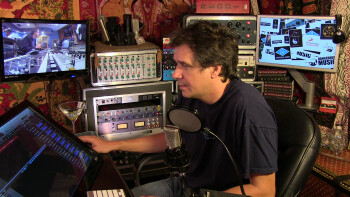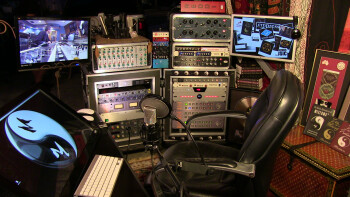When it comes to the world of recording, Mixerman has a lot to say and the cred to back it up. He’s a producer and mixer whose credits include Ben Harper, Lifehouse, Amy Grant, Pete Murray, and many others.
Mixerman is also a prolific chronicler of the recording world, and his books include The Daily Adventures of Mixerman, as well as Zen and the Art of Recording, Zen and the Art of Mixing, and Zen and the Art of Producing. All four titles are published by Hal Leonard, and Mixerman has recorded hours of instructional videos for the Multimedia Editions of his “Zen and the Art of” series.
Audiofanzine had a chance to speak with him recently, and, as expected, he had plenty of opinions about such subjects as drum miking, pro vs. “prosumer” gear, the accuracy of modeling plug-ins, and lots more.
You talked a lot about recording drums in the book, including the concept of “top down” drum recording. Can you explain what you mean by that?
Well, for a lot of people, the first thing they’ll go for is the kick drum and then the snare drum, and they’ll make those sound fantastic on their own, without any thought about how the entire thing works. Even I used to do that. And then I realized, “Why do I do that when 90% of the information is on the overheads and the rooms [room mics]. I probably accidentally had my overheads in some fabulous spot when I had that ”ah ha" moment. I then I realized that. The top down method keeps you from getting in trouble, because your close mics work in relation to the overheads.
So when you’re tracking drums, you start by listening through the overheads and getting a good blend without listening to the other mics at first?
It’s the difference between getting all your drum tones and then miking your cymbals, rather than trying to mic the entire kit. Sometimes you do want to just mic the cymbals, like if you want a very, “in your face” kind of sound. Let’s say it’s a metal album, I know I’ll have an “in your face” kick and snare and the cymbals. I don’t necessarily want the whole aggregate of the kit, rather I’m just going to mic the cymbals. Which means I’ll have the mics lower to the cymbals, and try to put the kit together that way. With the aggregate method, however, I’m capturing the image of the kit, and then I’m filling in the missing information. I’m going to actually spend time getting those overheads so that my aggregate balance is the best it can be. If I have the mics up here, and I’m getting a ton of room information and I’m really not getting a good balance, I’m going to bring the mics down a little bit so that everything comes into focus to the point where if I had to live with just those two mics, I could do it.
So you just spend a lot of time trying to get the overhead sounding great, and then the other mics are icing on the cake.
Or the room mics — depending on the room. Sometimes the rooms give you the aggregate picture.
For people who have a limited amount of gear. What would you say is a good minimal kind of setup? I’ve had some luck with 4-mic setups, two overheads, kick and snare.
I would never use 3 or 4 mics on anyone but a great drummer. That only works if the drummer really has great balance. The greater the balance of the drummer, the less mics you need.
Because the drummer has good dynamics?
Yeah. Because their dynamics are good, but more importantly because they play the instrument in balance. If I put two microphones over JR [studio drummer John Robinson] or over Matt Chamberlain — they’re perfectly in balance – you listen to them and you go, “Wow, that sounds really good like that.” You put it over a band drummer and you go, “I’ve got a big problem on the kick drum, ” or “I’ve got a big problem on the snare drum.” And you start adding microphones and compressors and you’ve got to create a balance that he’s not capable of creating on his own at this point in his career.
You also talked mentioned that low-ceilinged rooms — 8-feet high or less — don’t have sufficient height to capture a good stereo image from the overheads.
It causes a lot of problems, for sure.
What do you recommend for people that don’t have a choice, and have to record in rooms with low ceilings?
Put the mics low. You’re not going to get a good aggregate in a room that’s getting all choked up, and you’re getting acoustic compression because the room’s not big enough. And then you’re getting nodes and buildups. Your early reflections are going to kill you. So you’re best just to go as close miked as you possibly can.
So in that case, you don’t want to do the top-down method.
No, you can’t. Unless you want that sh**ty-sounding room.
In the book you talk a lot about what you feel are the disadvantages of “prosumer” gear. How do you define that? Because there’s shitty gear and then there’s pretty good gear that you can get that might be considered prosumer. Where do you draw the line?
I just did a post about this on Mixermania, because it’s actually changing dramatically. Somebody was asking how do you tell whether something is prosumer gear, and I started thinking about it, and it’s a pretty good question. So I started looking around, and I realized, okay, most prosumer gear has wall warts, and is insufficiently powered. If your gear is not sufficiently powered it’s going to cause all sorts of problems. Prosumer manufacturers take design shortcuts. If it has 1/4-inch outputs, that’s typically an indicator — especially if the main outputs are 1/4-inch.
Even if they’re balanced 1/4-inch?
Yes. But the thing is now, Antelope just sent me this Zen Studio interface. It’s unbelievably good. It’s got stupid good conversion, and the mic pres are really, really great. As far as clean mic pres, they’re really great. I don’t know how they distort yet. I have to be in the heat of battle. I don’t expect them to distort like the [Neve] 1073. Distortion is an important aspect of mic pres if you need it. But these mic pres are crystal clear. They’re beautiful; it doesn’t feel like it’s got holes in it. So, it’s got a wall wart. But, listen. Pros will use prosumer stuff. I remember when that RNC came out, I bought two of them immediately when they were 200 bucks a pair.
You’re referring to the FMR Audio Really Nice Compressor?
Yes. There’s prosumer gear that pros will use. But the thing is, I have all the other gear available, too. If the prosumer only has the prosumer gear available, then they’re limited by whatever the unintended distortion aspects of it are. Whatever the quality of the mic pre is. Whatever the quality of the conversion is. And usually, that comes along with relatively poor monitoring. You’re dead before you even start if your monitoring isn’t there.
Because you don’t know what you’re hearing.
You have no idea. I don’t have a problem with prosumer gear. The Zen Studio, you’ve got to put it in the prosumer classification, given how they built the things. But holy fuck — I’m getting one.
But the Zen Studio is still on the higher end of the prosumer market.
It is on the higher end, for sure. And listen, those guys have so many converter products and stuff, that you’re getting the benefit of their higher-end products. So, as far as an interface is concerned, the quality isn’t a surprise. It’s the mic pres that have me floored. In most interfaces, the pres are disposable. Not in the Zen studio.
If someone had a fixed amount of money to spend on putting a studio together, and you were advising them how to spend it, what would you recommend they spend the largest chunk on, mics and mic pres and converters?
I think that if you could get your room so you could reasonably tell what’s going on, so there are not major problems — particularly problems that you can’t really hear — then every decision you make from that point forward is a good decision, because you can hear. You have some way of knowing how your stuff translates. So making a room that actually translates in a way that you can wrap your head around is probably number one. It’s probably also the most expensive. I mean, you’re not going to ever get a small 10' × 10' bedroom to do what you want. I don’t care how much stuff you put in there. It’s too small. I tried, and I failed dismally. It cost me $12,000 when I tried to put together my first home room.
What happened?
I spent all this money putting it together, then I brought home this project from Australia, I mixed it. The guy was like, “These mixes are all fucked up.” I’m like, “Oh no.” I’m like going back and forth from my car. And I finally said, “I’ve got to take it to a room.” I rented out the studio down the street to do the mixes, and paid for it out of my own pocket. I wasn’t even going to build my room here, I have a much better space for it now, in this house. I wasn’t going to do it, but Wyn Davis [owner of Total Access Recording Studios in Redondo Beach] called me and said “I have two Foreigner albums I have to mix in a week, and I can’t do it. Can you mix one of them for me?” I was like, “Dude, I don’t have a room.” He was like, “You have all the gear you need to put a room together.” I said, “I’ll do it, I’ll do one track. If it’s fucked up, I’m not going any further.” So I sent it to him and he said, “It’s great.” So I set out to build the room after I finished that album, because it worked.
So I guess people need to get their rooms acoustically treated.
Again, if you don’t have enough space, then it’s not worth it. You’re just going to have to use smaller speakers and turn it down low. The more problematic the room, the lower you’ve got to listen at. Even my room that I have now. As much as it’s one of the more accurate rooms that I’ve ever worked in, which is astounding to me, when I start going above 90 dB, it starts to really crumble a bit in there. So even I’ve got to keep it down to some degree.
Back to one other thing about drums: In the book you talked about re-amping a drum kit if you recorded in a room that didn’t have great sound. How would that work? You send it out to a PA in a big room?
Yeah. I’ll use a bus. I’ll send out bus 1 and 2 to the room. There are speakers there. I set up room mics, basically. I get them off the speakers.
You’re reamping the whole kit at once?
Yeah, and I just listen to the room, and I’m like “I need more kick in this room, ” or “I need more snare, ” or whatever.
The fact that it’s going through speakers doesn’t change it too much?
It’s different. It’s not like doing it in a real room, but it can be better than digital reverb.
So you use that in addition to the drum tracks you recorded, like an additional room mic?
Yeah, just to give it a little reverb. It’s just a chamber, basically.
You talked about your preference for hardware processors over plug-ins. Obviously, it’s not as easy to use them, not to mention a lot more expensive. Do you still use a lot of outboard when you’re mixing?
Not so much when I’m mixing, it’s a pain in the ass. The problem is we don’t have real inserts. And I can’t wait until someone solves this problem…I don’t even try to use analog gear in the mix, other than the 2-bus, at this point. Plug-ins have improved like a mind boggling amount just in the past four years. And they’ve improved steadily since we started using them. This whole modeling thing is so fucked up when you think about it.
Why is that?
When I recorded to tape, I wasn’t trying to get tape saturation. I was trying to avoid tape saturation, unless I wanted that particular effect, which I did sometimes — but not on everything all the time. But these kids think, “Oh, I’m adding tape to my thing, ” but what they’re adding is this fake smearing of their audio to simulate the artifacts that happen when you push tape too hard — the electronics and the tape. You’re smashing down you’re transients. And listen, there’s nothing wrong with that if that’s what you want it to sound like. But some of these kids think that’s what tape sounds like. I printed a mix to 1/2"-inch tape a few years back, and my client was so interested in coming and listening and comparing the two. He was so confused. He said, “Wait, why does it still have the top end?” I’m like, “What?” They think that tape wasn’t accurate or something. In the '90s and '00s, I felt that tape was actually way more accurate than 99% of the converters that were out there at the time.
I guess the feeling of digital being too cold, and the idea that tape offered a less sterile, warmer sound is what drives all those modeling plug-ins being developed. What about products that emulate hardware compressors and other signal processors. Do you think they even come close to the originals?
The problem is they end up being caricatures of the hardware. Like the FET compressor that Apple has, it sounds like a FET compressor — it adds distortion properties. But it’s severe. On a real FET compressor like an 1176, or if I’m using like the Empressor, that is to say, the [Empress Effects] ECM 519, which is a new FET, I can really control how much distortion I’m adding. On the plug-ins, it’s either like a lot of distortion or none. Okay, yeah, it reminds me of a FET compressor, it does a lot of things that remind me of a FET compressor. The VCA sounds more like a VCA compressor than a FET compressor, but they’re still just shadows of what’s actually happening, but they’re still just mimicking what those things do. And you cannot mimic how program reacts in electronics, because it’s so complicated.
I heard some people say it’s just getting a snapshot of a moment in time of how the unit reacts in one situation.
How does that 1176 react to a bass compared to a vocal compared to a snare drum compared to something with a big transient, compared to something with a long slow [attack], you know. It’s going to react differently in all those cases. I mean, look, how many times have I said to myself, “Ok, I’m going to put an 1176 on this kick drum, ” because I had this sonic picture in my head. And then I put it on the kick drum and it didn’t work. So I switched the compressor. Is that because I don’t know what an 1176 sounds like? Or is it because there’s some certain amount of hit or miss that’s involved here? That’s what’s missing from the plug-ins, for the most part, I find.
Do you think modeling plug-ins will eventually get to a point of accuracy that satisfies you?
I think it’s really going to be a matter of processing power, at the end of the day, which gets us to models that are doing what that analog gear was doing.
Let’s talk about the book. You produced video to go with it. How do people get to the videos?
They’re in the digital product — in the digital version of all three books. Well, just Recording now. Producing and Mixing come out in the next couple of weeks.
Talk about the videos.
It’s really hard to show mic placement in a book. So this way, they can see it. I showed them two ways of miking up a Leslie/B3. And then I went and compared the two, and at one point I did a switch between them and you can’t even tell the difference. So I’m illustrating that your mic placement is important, but if you have well placed mics, it’s not going to change the tone. It’s still Patrick Moraz, in the case of my clips, . So don’t put too much stock in that stuff, it’s all about the source. If the source is good, you’re not going to have problems. The books are popular, but I think the videos are really going to make the product more appealing to the younger kids.





